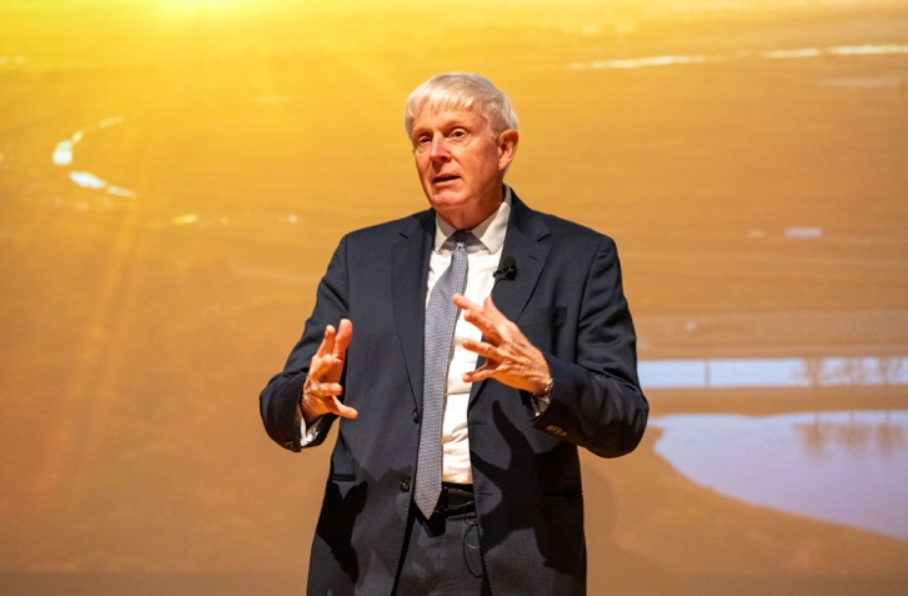Insider Brief
- Researchers demonstrated a tunable, room-temperature second-harmonic electrical response in the quantum magnet TbMn₆Sn₆, driven by the material’s quantum metric.
- The effect arises when both time-reversal and inversion symmetry are broken, a condition achieved near the material’s spin-reorientation transition using small magnetic fields.
- The findings suggest potential for practical quantum-geometry-based devices without the need for cryogenic cooling.
A study published in Nature Communications demonstrates that a magnetic crystal, a quantum magnet known as terbium manganese tin — TbMn₆Sn₆ — can exhibit strong and tunable quantum transport effects at room temperature, a rare feat that could help bridge quantum theory with next-generation electronics.
Researchers from Monash University, the Weizmann Institute, and several other institutions observed a nonlinear electrical response tied to the material’s so-called quantum metric, a geometric property of electron wavefunctions. It’s important to note that this effect was not just present at room temperature but could be precisely controlled using magnetic fields. The work paves a potential path toward compact, efficient devices that exploit quantum geometry without the need for extreme cooling.
The researchers write: “We show that around room temperature, which is close to the spontaneous spin-reorientation transition, the magnetic configurations, and therefore the related symmetry breaking phases, are easily controlled via magnetic fields. Our results also show that manipulation of the symmetries of the magnetic structure presents an effective route to tuneable quantum-geometry-based devices.”

From Abstract Geometry to Tangible Technology
Quantum geometry — the study of how electron states change in momentum space — underpins a number of strange and promising phenomena in quantum materials. Two important aspects of this geometry are the Berry curvature and the quantum metric. The Berry curvature has previously been linked to topological effects like the anomalous Hall response, while the quantum metric governs how strongly a material responds to electric fields in nonlinear ways, such as producing higher harmonics of a signal.
These effects have remained mostly academic due to one major limitation: they usually require cryogenic conditions. Past studies have shown quantum metric–induced responses in materials like an intrinsic antiferromagnetic topological insulator called Manganese bismuth telluride (MnBi₂Te₄) — but only at temperatures well below 30 K, which severely limits commercial viability.
The new findings, if they hold up to scientific scrutiny, could change that. By focusing on terbium manganese tin — which is a kagome-lattice magnet with rich internal spin textures — researchers observed robust second-harmonic voltage signals at 300 K, governed by the quantum metric and modifiable via applied magnetic fields.
Inside the Kagome Crystal
The crystal at the center of this study, terbium manganese tin, belongs to a class of materials known as kagome magnets, or quantum magnets, named after a Japanese basket-weaving pattern resembling the triangular lattices in the material’s atomic structure. These geometries are fertile ground for quantum behavior, especially when combined with magnetic order.
At room temperature, terbium manganese tin sits near a spontaneous spin reorientation transition — in simple terms, that’s a change in the direction of its internal magnetic moments. This transitional region allows the researchers to exploit small magnetic fields to toggle the material’s internal symmetry. That symmetry breaking is key: the quantum metric requires both time-reversal and inversion symmetry to be broken in order to produce a measurable second-order electrical response.
That sounds complicated, but scientists liken this to breaking the mirrored choreography of a perfectly symmetrical dance. In a system with unbroken symmetry, every motion is countered by an equal and opposite one, canceling out any net effect. But when the symmetry is disrupted — when the dance falls slightly out of sync in both time and space — new patterns can emerge. In this case, that asymmetry unlocks a second-order electrical response, allowing the quantum geometry of the material to influence how electrons move. Without breaking both mirrors, then, the signal remains hidden.
In the study, the team fabricated two microscopic Hall bar devices from single-crystal samples using focused ion beam techniques. By applying alternating current and measuring the voltage at double the input frequency, they detected a strong second-harmonic transport signal. Importantly, the signal could be decomposed into two parts: one that did not change with magnetic field and another that flipped when the field direction was reversed. The latter behavior is a fingerprint of quantum metric effects.
Evidence for a Quantum Metric–Driven Response
To isolate the quantum metric’s contribution from other sources of nonlinear signal — such as extrinsic effects like Joule heating or classical nonlinear scattering — the team had to perform a careful analysis. They ruled out traditional Drude-model behavior and skew-scattering mechanisms by comparing the scaling of the response with current density and relaxation time.
They also compared two device geometries: one with the magnetic field applied perpendicular to the kagome plane and one with the field in-plane. The second-harmonic signal was significantly stronger when the field was out-of-plane, consistent with theoretical expectations that the required symmetry breaking (inversion and time-reversal) only occurs under those conditions.
At the electronic level, the researchers attributed the signal to a “quantum metric dipole,” a term used to describe how the quantum metric varies across different momentum states in the material. This dipole enables nonlinear transport by allowing different parts of the electronic structure to respond unevenly to an electric field.
Real-World Relevance
The findings are not just theoretical advances, but could, in the broader context of quantum materials research, be important for real-world outcomes for two reasons: temperature and tunability. The second-harmonic signal is not only measurable at room temperature — a rare trait for quantum geometry effects — but also responds in predictable ways to applied magnetic fields. That’s a requirement for any practical device built on these principles.
Previous candidates for quantum metric–driven devices — such as Manganese bismuth telluride or the layered kagome superconductor called Cesium vanadium antimonide (CsV₃Sb₅) — either required cryogenic cooling or lacked tunability. In contrast, terbium manganese tin demonstrates both high-temperature operation and external controllability.
The study also showed signs of additional complexity, including contributions from skyrmions, which are nanoscale magnetic whirlpools that can generate their own nonlinear electrical effects. By disentangling the contributions of quantum geometry and skyrmion dynamics, the researchers built a more comprehensive picture of the underlying physics and offered a roadmap for exploiting each independently in future applications.
Implications for Quantum Technologies
This development is likely to be of particular interest for researchers working in spintronics, neuromorphic computing and quantum sensing. Nonlinear devices that respond selectively to frequency or direction could be used in energy-efficient computing elements, tunable filters, or signal rectifiers that operate without traditional semiconductors.
For the quantum tech community in particular, the finding offers proof that quantum geometry is no longer confined to blackboard theory or deep cryogenic labs. As more materials with topologically rich magnetic structures come into focus, the ability to harness room-temperature quantum metrics could unlock new device classes.
The researchers emphasize that the unique magnetic structure of terbium manganese tin, which allows for both in-plane and out-of-plane magnetic tuning, makes it an ideal platform for further study. Future work will likely focus on integrating such materials into prototype devices and exploring their response under different stimuli, such as strain or optical pumping.
Limitations and Future Work
While the results are promising, there are limitations that will serve as focus points for future research. The current study relied on precise microfabrication and measurement techniques that may not yet scale easily to wafer-level processing. Additionally, although the nonlinear signal is strong and tunable, further optimization will be needed to reach the efficiency levels required for commercial circuits.
The team also notes that the interplay between quantum metric and skyrmion effects in terbium manganese tin is complex, and further theoretical and experimental work will be needed to fully separate and harness these contributions. Understanding how to trigger and control each effect independently could lead to multi-functional devices where a single material performs multiple roles.
The study was led by Weiyao Zhao, Kaijian Xing, Yuefeng Yin, and Yang Liu from Monash University; Yufei Zhao and Binghai Yan from the Weizmann Institute of Science; Lei Chen and Min Hong from the University of Southern Queensland; Dang Khoa Le and Jacob Gayles from the University of South Florida; Fang Tang and Yong Fang from the Changshu Institute of Technology; and Julie Karel, also from Monash University, who served as the corresponding author..


















